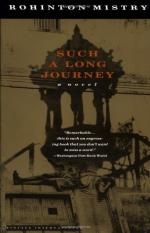|
This section contains 517 words (approx. 2 pages at 400 words per page) |

|
Such a Long Journey Summary & Study Guide Description
Such a Long Journey Summary & Study Guide includes comprehensive information and analysis to help you understand the book. This study guide contains the following sections:
This detailed literature summary also contains Topics for Discussion and a Free Quiz on Such a Long Journey by Rohinton Mistry.
Such a Long Journey examines the life of a handful of Parsi Indians in the turbulent early 1970's. When Britain withdraws from the subcontinent in 1948, two states are created. Muslims form one state, Pakistan. Pakistan's two parts are widely separated by its massive southern neighbor, India. In India, Hindus predominate, although society is officially secular. Parsis are a tiny, secretive religious minority.
The inhabitants of Khodadad Building north of Bombay are all Parsis. The most pious of them is Gustad Noble, the novel's protagonist. He works in a Parsi dominated bank downtown. Gustad intends that his eldest son, Sohrab, who excelled in secondary and college studies, attend the Indian Institute of Technology (IIT) and find a career more lucrative and prestigious than his own. Gustad bears many grudges from the past, which have limited his possibilities.
Sohrab, an artist at heart, rejects the plan. The hardheaded father and son clash and turn their backs on each other. Gustad's middle child, a son named Darius, causes only minor problems. Gustad's 9-year-old daughter, Roshan, is chronically ill, though. The illness brings Gustad into contact with a politically active doctor. Gustad's superstitious wife, Dilnavaz, falls under the sway of an upstairs neighbor who practices both black and white magic.
A Parsi mystic advises Gustad's sworn enemy. Another eccentric old Parsi rages out his window at the unfairness of the Almighty. A tragic and mentally deficient young man wanders about, delivering messages and playing. His mind was destroyed after falling from the neem tree at the center of the compound.
Although Gustad's war hero best friend, Major Jimmy "Bili Boy" Bilimoria, has vanished from the apartment complex, he writes to Gustad to ask a favor. Gustad follows his friend's instructions and receives a very large amount of cash. Gustad is forced into depositing it gradually into a false bank account. Then he is compelled to withdraw it even more rapidly. It is clear Gustad is dealing with terrorists. Gustad is forced to involve another friend, the cancer-riddled, lecherous Dinshawji. Dinshawji's hospitalization, death, and funeral force Gustad to contemplate anew the mysteries of life.
Jimmy Bilimoria reveals the sordid political story behind the money laundering, during a heartbreaking visit Gustad makes to his friend's prison hospital bedside. The shadowy lieutenant who serves as intermediary between Jimmy and Gustad makes clear Major Bilimoria's natural death in prison was a murder.
The novel's climax comes when the denizens of an especially depressed neighborhood, march to the municipal buildings to demand essential services. On the way, they pause at the wall outside Gustad's business, which a street artist has covered with depictions of the gods and holy people of all the religions of India. The municipality has decreed it will be demolished to widen the road. In a violent street fight, Tehmul, the tragic cripple into whom Dilnavaz drew her son's evil demons, dies while trying to catch a brick. Gustad's lifetime of frustrations and anger melts as he prays over the victim's body. Sohrab and Gustad embrace. Although the sacred wall is demolished, so too is the limiting, bleak past.
Read more from the Study Guide
|
This section contains 517 words (approx. 2 pages at 400 words per page) |

|



